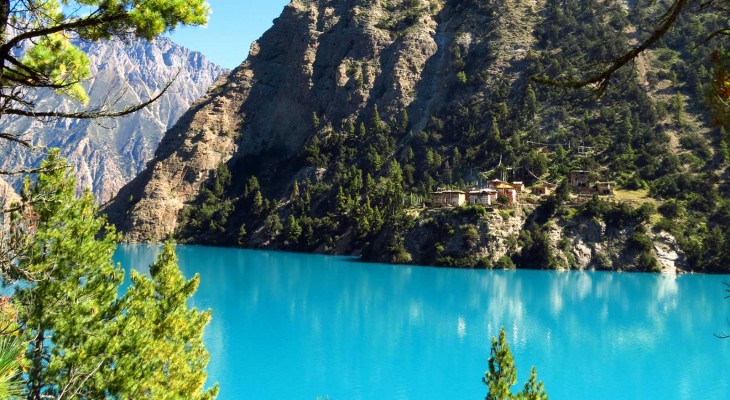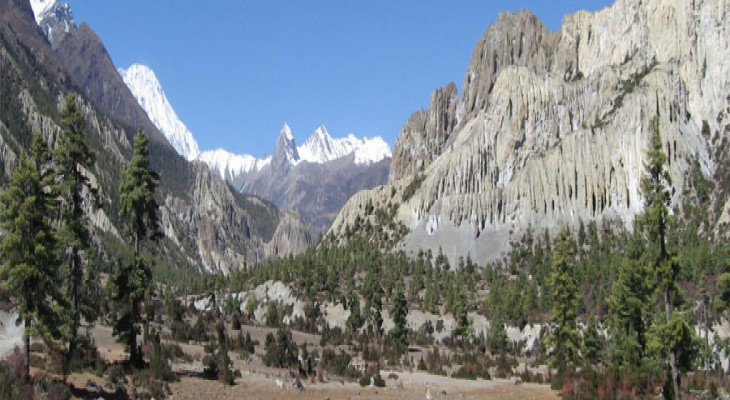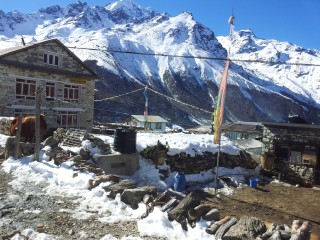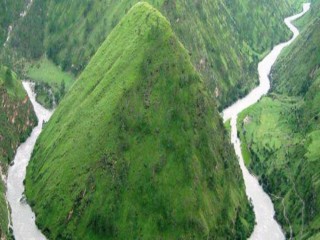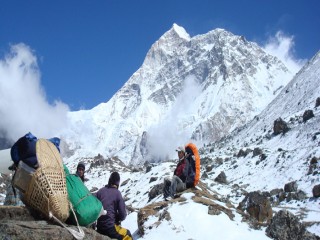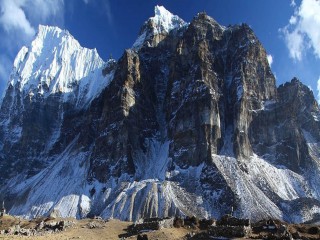Introduction
The Lower Dolpo trek involves crossing two high passes Numala Pass (5115m) and Bagala Pass (5100m). Both of these passes look out to a splendid panorama of Himalayas in the North including Dhaulagiri and Annapurna. Trek highlights include visiting Shey Phoksundo National Park and Shey Phoksundo Lake (3660m). Shey Phoksundo National Park is the largest and only trans-Himalayan National Park in Nepal.
Surrounded by Tibet in North and highest Dhaulgari Massif in South, the Dolpo region is the natural embodiment of high passes, rare flora and fauna and sweeping Himalayan vistas. The medicinal plant, Yarchagumba (Coreopsis sinensis) a type of wild mushroom is found in abundance in this region, oft recognized for its benefits of improving health and fitness.
Outline Itinerary
Day 1 Fly from Kathmandu to Nepalgunj.
Day 2 Fly to Jumla (2370m) and trek from Jumla to Gothi chaur (2700m).
Day 3 Trek from Gothi Chaur to Naphukana (3080m).
Day 4 Trek from Naphukana to Chaurikot (3060m).
Day 5 Trek from Chaurikot to Bheri riverside (2610m).
Day 6 Trek from Bheri riverside to Garpung khola (2900m).
Day 7 Trek from Garpung Khola to Kagmara (3500m).
Day 8 Trek from Kagmara to Kagmara phedi (4000m).
Day 9 Cross Kagmara La (5115m).
Day 10 Trek to Pungmo.
Day 11 Trek from Pungmo to Phoksumdo Lake.
Day 12 Today is a rest day at Phoksumdo Lake which is known for its unusual greenish-blue coloring.
Day 13 Trek from Phoksundo Lake to Baga La phedi.
Day 14 Cross Baga La (5090m) and trek to Numa La phedi (4800m).
Day 15 Cross Numa La (5360m) and trek to Do (4100m).
Day 16 Today is a rest day at Do which is the largest settlement in Tarap and has several gompas.
Day 17 Trek from Do to Lahini (3560m).
Day 18 Trek from Lahini to Tarakot (2600m).
Day 19 Trek from Tarakot to Dunai (2100m).
Day 20 Trek from Dunai to Juphal (2500m).
Day 21 Fly from Juphal to Kathmandu via Nepalgunj.
Day 1 : Fly from Kathmandu to Nepalgunj.
You will be escorted to the airport for the flight to Nepalgunj which lies close to the Indian border in the western Terai. You stay overnight at lodge.
Accomodation :
Day 2 : Fly to Jumla (2370m) and trek from Jumla to Gothi chaur (2700m).
This morning you fly from Nepalgunj to Jumla. Leaving the airport at Jumla, you cross the Tila Khola and the Chaudabise Khola near their confluence and climb gradually to a fertile valley of rice terraces. The trail continues through several villages before passing through a forest of maple and walnut to a meadow which, in season, is covered in wildflowers. Beyond the meadow, the trail climbs to a small pass before descending again to Gothi Chaur. You stay overnight in camp.Accomodation :
Day 3 : Trek from Gothi Chaur to Naphukana (3080m).
Today's walk follows the Tila Khola through fields of corn, potato, buckwheat and barley until the valley narrows and you enter a forest of oaks, spruce and maples. You pass through the village of Chotra with its typical Tibetan mani walls and a short distance come to another Tibetan-looking village, Naphukana. Above this village, there is a large gompa. You stay overnight in camp.Accomodation :
Day 4 : Trek from Naphukana to Chaurikot (3060m).
From Naphukana the trail becomes steeper and climbs through a forest to a pass named Mauri Lagna [3820m]. From the pass there are views of snowy peaks to the north and east. Descending from the pass, the trail traverses a steep slope before dropping into a forest of pine and oak. You then enter the Bheri Valley and, after following the trail in and out of side valleys, you come to the village of Chaurikot. Your camp will be near the village.Accomodation :
Day 5 : Trek from Chaurikot to Bheri riverside (2610m).
Continuing on to the village of Balasa you can see Kagmara peak on the horizon. The trail drops to a stream before climbing through a forest of walnut trees to a ridge. Passing through the apple orchards of Jyakot, you then descend to the village of Rimi before following a rocky trail down to the Bheri River. Your camp will be by the river.Accomodation :
Day 6 : Trek from Bheri riverside to Garpung khola (2900m).
You stay on the west bank of the Bheri River, passing Hurikot and arrive at the entrance to the Shey Phoksumdo National Park. You then come to the confluence of the Garpung and Jagdula Rivers, which join to form the Bheri River, and follow the Garpung Khola. You stay overnight in camp.Accomodation :
Day 7 : Trek from Garpung Khola to Kagmara (3500m).
You continue to follow the Garpung Khola, ascending slowly towards the Kagmara La. You stay overnight in camp.Accomodation :
Day 8 : Trek from Kagmara to Kagmara phedi (4000m).
You now cross to the eastern side of the river and where the valley narrows, the river becomes a series of waterfalls. The trail climbs to a moraine below the Kagmara La and you make your camp among the boulders. The views from here of the surrounding peaks are magnificent. You stay overnight in camp.Accomodation :
Day 9 : Cross Kagmara La (5115m).
You get an early start this morning and ascend alongside the Kagmara Glacier to the Kagmara La. This is a good place to spot the rare blue sheep. After a 900m descent, you reach the pastures of the Pungmo Khola Valley. You stay overnight in camp.Accomodation :
Day 10 : Trek to Pungmo.
The trail now enters birch and juniper forests which soon give way to blue pine. Up the side valleys, there are views of Kanjirolba peak before you reach the fortress-like village of Pungmo, set amidst barley fields. You stay overnight in camp.Accomodation :
Day 11 : Trek from Pungmo to Phoksumdo Lake.
You continue downstream to the national park headquarters at Sumduwa before joining the trail up the Phoksumdo Khola to Phoksumdo Lake. You climb through a forest of large cedars to the winter settlement of Palam and continue ascending through the open country to a ridge from which there are good views of the lake in the distance. Close by is a spectacular waterfall, the highest in Nepal. The trail then makes an initial descent before climbing gently to Ringmo village. After crossing a bridge below Ringmo, the trail continues northwards to the shores of Phoksumdo Lake. You stay overnight in camp.Accomodation :
Day 12 : Today is a rest day at Phoksumdo Lake which is known for its unusual greenish-blue coloring.
It is overlooked on the western side, by a large snowy peak known as Kanjirolba or Kanchen Ruwa. A trail leads through a stand of juniper trees to an old dilapidated gompa which overlooks the lake. As well as Buddhist paintings and statues, there is also evidence of the ancient Bon-po religion within the temple and chapels. You stay overnight in camp.Accomodation :
Day 13 : Trek from Phoksundo Lake to Baga La phedi.
You retrace your route as far as Ringmo and then follow trail eastwards through forests of juniper and blue pine. The trail follows the river up the valley to a waterfall and you will camp here at the base of the Baga La. You stay overnight in camp.Accomodation :
Day 14 : Cross Baga La (5090m) and trek to Numa La phedi (4800m).
From your camp it's a steady 3 hour climb to the top of the Baga La, the second of the high passes. The descent is gradual at first but it soon drops steeply to a stream before ascending again to the foot of the Numa La. You stay overnight in campAccomodation :
Day 15 : Cross Numa La (5360m) and trek to Do (4100m).
You continue climbing through arid country to the last of the high passes, the Numa La. It is marked by mani stones and, if it is a clear day, you can see as far as Dhaulagiri. The trail now descends past a huge mani wall to the Tarap region and you walk through the barley fields of the Tarap Valley to the settlement of Do. You stay overnight in camp.Accomodation :
Day 16 : Today is a rest day at Do which is the largest settlement in Tarap and has several gompas.
On the ridge above the village is the Ri Bhunpa Gompa and just to the east, the village of Shipchhok has a Bon-po gompa which is certainly worth exploring. There are also opportunities to get great views of the valley and surrounding snow peaks from a number of nearby ridges. You stay overnight in camp.Accomodation :
Day 17 : Trek from Do to Lahini (3560m).
This morning's walk is almost level and follows the river until it flows into a gorge. You enter the gorge which has large rose shrubs and other wildflowers, and after crossing and re-crossing the river numerous times you finally come to a flat expanse. You stay overnight in camp.Accomodation :
Day 18 : Trek from Lahini to Tarakot (2600m).
The trail today is steep, narrow and dangerous as it clings to the cliffs. The bridges along here can often be washed out. Eventually, the valley widens and the route becomes easier as you approach the village of Khanigaon. You then climb high above the river before descending towards the Barbung Khola and the fortress village of Tarakot. You stay overnight in camp.Accomodation :
Day 19 : Trek from Tarakot to Dunai (2100m).
You follow the Barbung Khola downstream along the south bank to the village of Lawan, before crossing to the north bank and walking for several more hours to Dunai. You stay overnight in camp.Accomodation :
Day 20 : Trek from Dunai to Juphal (2500m).
From Dunai, you continue to follow the river downstream through Roop Ghar and Kala Gaura before climbing up through meadows to the airport at Juphal. Your final night's campsite will be near the airfield. You stay overnight in camp.Accomodation :
Day 21 : Fly from Juphal to Kathmandu via Nepalgunj.
You catch an early flight to Nepalgunj and from there, a connecting flight back to Kathmandu. You catch an early flight to Nepalgunj and from there, a connecting flight back to Kathmandu. You catch an early flight to Nepalgunj and from there, a connecting flight back to Kathmandu. You catch an early flight to Nepalgunj and from there, a connecting flight back to Kathmandu. You catch an early flight to Nepalgunj and from there, a connecting flight back to Kathmandu. You catch an early flight to Nepalgunj and from there, a connecting flight back to Kathmandu.Accomodation :
Features Included on Lower Dolpo Trek
Features Not Included on Lower Dolpo Trek
Things To know
Requirement
Equipments & Packing List
This list is a guideline to help you pack for your adventure. Also understand that the items listed below will vary a little according to the season and the trek duration. Those items marked by an asterisk (*) are provided by Himalayan Glacier inclusive in the service. The weight limit for your luggage is 33 pounds or 15 kg. Remember that your luggage will be carried by your porter but you are required to carry a day-pack (with your valuables or anything important) on your own. We also suggest that you pack only what is necessary.
Important documents and items
- Valid passport, 2 extra passport size photos, airline tickets
- Separate photocopies of passport, visa form (easily obtained at Kathmandu airport), proof of insurance
- Dollars, pounds or Euros in cash for purchasing Nepalese visa at Kathmandu airport, for paying for restaurants and hotels, for gratuities, snacks, and to purchase your own drinks and gifts
- Credit cards, Bank/ATM/Cash machine cards for withdrawing funds from cash machines (bring a photocopy of your cards), traveler's checks, etc.
Head
- Bandana or head scarf, also useful for dusty conditions
- Warm hat that covers your ears (wool or synthetic)
- Headlamp with extra batteries and bulbs
- Sunglasses with UV protection
- Prescription sunglasses (if required)
Upper Body
- Polypropylene shirts (1 half sleeve and 2 long sleeves)
- Light and expedition weight thermal tops
- Fleece wind-stopper jacket or pullover
- Waterproof (preferably breathable fabric) shell jacket
- Down vest and/or jacket *
- Gore-Tex jacket with hood, waterproof and breathable
Hands
- 1 pair of lightweight poly-liner gloves.
- 1 pair of lightweight wool or fleece gloves
- 1 pair of mittens, consists of 1 Gore-Tex over mitt matched with a very warm polar-fleece mitt liner (seasonal)
Lower Body
- Non-cotton underwear briefs
- 1 pair of Hiking shorts
- 1 pair of Hiking trousers
- 1 pair of lightweight thermal bottoms (seasonal)
- 1 pair of fleece or woolen trousers
- 1 pair of waterproof shell pants, breathable fabric
Feet
- 2 pairs of thin, lightweight inner socks
- 2 pairs of heavy poly or wool socks
- 1 pair of Hiking boots with spare laces (sturdy soles, water resistant, ankle support, “broken in”)
- 1 pair of trainers or running shoes and/or sandals
- Cotton socks (optional)
- Gaiters (winter only), optional, “low” ankle high version
Sleeping
- 1 sleeping bag (good to -10 degrees C or 14 degrees F)*
- Fleece sleeping bag liner (optional)
Rucksack and Travel Bags
- 1 medium rucksack (50-70 liters/3000-4500 cubic inches, can be used for an airplane carryon)
- 1 large duffel bag *
- A small daypack/backpack for carrying your valuables, should have good shoulder padding
- Small padlocks for duffel-kit bags
- 2 large waterproof rucksack covers (optional)
Medical
- Small, personal first-aid kit. (simple and light)
- Aspirin, first-aid tape, and plasters (Band-Aids)
- 1 skin-blister repair kit
- Anti-diarrhea pills
- Anti-headache pills
- Cough and/or cold medicine
- Anti-altitude sickness pills: Diamox or Acetylzolamide
- Stomach antibiotic: Ciprofloxacin, etc. Do not bring sleeping pills as they are a respiratory depressant.
- Water purification tablets or water filter
- 1 set of earplugs
- Extra pair of prescription glasses, contact lens supplies
Practical Items
- 1 small roll of repair tape, 1 sewing-repair kit
- 1 cigarette lighter, 1 small box of matches
- 1 compass or GPS(optional)
- 1 alarm clock/watch
- 1 digital camera with extra cards and batteries
- large Ziplocs
- 2 water bottles (1 liter each)
- 1 small folding knife
- Binoculars (optional)
- 4 large, waterproof, disposable rubbish sacks
Toiletries
- 1 medium-sized quick drying towel
- Toothbrush/paste (preferably biodegradable)
- Multi-purpose soap (preferably biodegradable)
- Deodorants
- Nail clippers
- Face and body moisturizer
- Female hygiene products
- Small mirror
Personal Hygiene
- Wet wipes (baby wipes)
- Tissue /toilet roll
- Anti-bacterial hand wash

